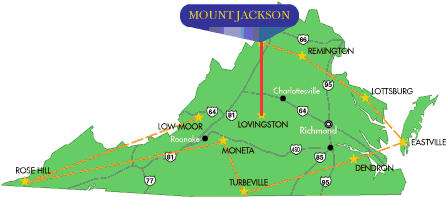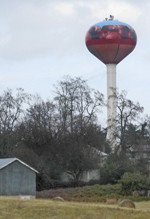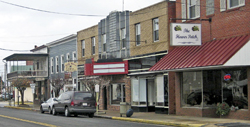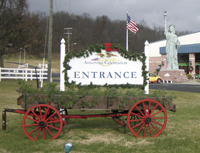Download
in PDF Format
The
distinctive �Basket of Apples� water tower alongside Interstate 81
midway between Winchester and Harrisonburg is a now-famous landmark up and
down the East Coast.
Mount
Jackson is the town behind this landmark and is today a thriving town with
a rich community history that stretches back to the valley�s
pre-industrial age. The basket of apples image that travelers talk about
is actually a photograph of real Virginia apples.
|

Mount
Jackson's distinctive water tower is a well-known landmark on
Interstate 81. |
Many
factors can lead to the formation of a settlement in a particular region,
and the abundance of water is the reason a town grew up at the convergence
of Mill Creek and the Shenandoah River in today�s Shenandoah County. In
pre- industrial America, the main source of energy
was muscle power from people and animals, or water power from flowing
streams. Water wheels captured the energy from falling water to power
mills. At one point, six mills were located along Mill Creek in Mount
Jackson. Electric cooperatives were more than a century away.
In
the 1740s, Peter Jefferson surveyed the Fairfax line (today, a part of
this line serves as the boundary between Rockingham and Shenandoah
counties). In their journals, the survey team mentions the settlements to
the north along Mill Creek. Peter�s son, Thomas, went on to fame in the
latter part of the 18th century.
Mount
Jackson was named in honor of Tennessee�s Andrew Jackson in 1826. In the
controversial presidential election of 1824, no candidate won the required
majority of electoral votes and the presidential decision was turned over
to the U.S. House of Rep-resentatives. Candidate Andrew Jackson had won
the majority of the popular vote, but in a surprise decision, the House
gave the presidency to John Adams. In 1828, Jackson again ran for
president. That time he was the clear winner in both popular and electoral
votes. But the town name was changed before Jackson became president.
The
Manassas Gap Railroad arrived in Mount Jackson in 1858. Local agricultural
producers now had a faster, more convenient method of supplying food to
Washington and Richmond. The railhead here was an important distribution
point for manufactured products shipped to the central valley from the
eastern cities.
|

Main
Street, Mount Jackson |
The
rail line also nourished the developing tourist industry. West of town the
Orkney Springs Hotel welcomed guests with cool summer breezes and water
from seven different mineral springs. A horse-drawn coach made several
daily round trips to the springs from the train station. Today, the
original Orkney Springs Hotel is part of the Episcopal Diocese of
Virginia�s Shrine Mont Conference Center. Shrine Mont�s outdoor
cathedral is the designated home of the Virginia Diocese. Visitors are
welcome at the conference center.
Every
summer, Orkney Springs Hotel hosts the Shenandoah Valley Music
Festival�s outdoor concerts on the lawn. Eight concerts are
traditionally held the last two weekends in July, one August weekend, and
Labor Day weekend.
Another
local mountain hideaway began as a summer retreat called Bryce�s
Mountain Resort in 1909. Today�s modern resort offers downhill skiing
and snow tubing in winter with golfing, swimming, and an aerial zip line
in the warmer months. In 1966 Pete Bryce began the ski operations and
added a small airport. OntheSnow.com readers ranked Bryce�s ski resort
as the best family-friendly resort of 2008.
Mount
Jackson is rich in history, and historical sites, as the Civil War swirled
around the area.
Stonewall
Jackson�s Valley Campaign in 1862 passed through town twice on the
Valley Turnpike. Sheridan�s later burning of valley farms in the fall of
1864 devastated the local farm economy.
The
Confederate government built a 300-bed hospital in
Mount Jackson in 1861. Wounded soldiers from battles in Virginia,
Maryland, and Pennsylvania found their way by rail or wagon to this
hospital. Mid-19th-century standard medical procedures are frightening
when viewed from a modern perspective. After what must have been long and
painful journeys, many of these men � if they lived long enough to make
it to the hospital � later died from fevers, infections, and disease.
The
Soldiers Cemetery is located across the Valley Turnpike from the hospital
site. Some 450 Confederate soldiers from 11 southern states are buried
there. Its memorial statue was dedicated in 1903. The late Coiner Rosen, a
well-known local businessman, was instrumental in compiling research on
the cemetery and was always willing to volunteer his time and stories.
Joseph
Williams moved to Mount Jackson in 1960. �Our community is special
because of our volunteers,� he says. �We have people from all walks of
life giving their time to community projects. If you ask someone to do
something, they say yes. That makes you feel good about your town.�
Williams was elected mayor in 1998 after a successful write-in vote where,
as part of his campaign, he gave everyone a pencil.
The
Mount Jackson Visitor�s Center and Town Hall was dedicated in 2003 and
is becoming the heartbeat of the community. The one building serves many
purposes. The Community Library occupies the northeast corner and holds
9,000 books and seven computers with high-speed Internet. The museum
presents many interesting historical Mount Jackson artifacts with a focus
on local items. The Town Hall and police department occupy the south side
of the building. The central hall is the Visitor�s Center, which can
seat 100 people.
The
Art Group is Mount Jackson�s artists� center on Main Street.
Established in 1999 and run by artists, the Art Group�s gallery features
rotating exhibits by local artists, with a student exhibit in late winter.
Art classes are available, and the �First Friday� event is a local
social highlight. On the first Friday of each month, local musicians
perform a free concert in the warm back gallery.
|

Renovations
to the local landmark Union Church uncovered graffiti left behind
by soldiers during the Civil War. |
Giving
back to the community has been a long tradition in Mount Jackson. The
local landmark Union Church was a gift in the 1820s to the community. Most
local churches made use of the Union Church as their startup meeting place
until they could secure money for their own church buildings.
Renovations
to the Union Church in the early 1990s uncovered graffiti left behind by
Union solders stationed in the area during the Civil War. The Union church
is open and staffed by volunteers on spring, summer, and fall weekends.
The surrounding cemetery contains Revolutionary War veterans, Confederate
veterans, and several Virginians who were born under the realm of King
George III.
Just
south of town is one of Virginia�s remaining covered bridges still open
to traffic. Constructed in 1892, the 191-foot span has been a local
tourist spot for years. Bridges were covered to protect the wooden deck
and beams from weather. The Mount Jackson Garden Club, with the �muscle
help� of the local FFA, cleared a small picnic area at the foot of the
bridge. �We planned for a place for people to enjoy the river,� says
club member Marcia Brownfield. The club has also undertaken a project to
replenish the tree line along the lane leading to the bridge.
The
Search Thrift Shop on Main Street has been an institution since opening in
1977. The newly renovated shop in the old rescue squad building draws
shoppers five days a week. �A thrift-shop survey ranked this shop as one
of the best in the mid-Atlantic region,� says Helen Green, administrator
of the Search Adult Group Home. �The store is our outreach to the
community.� Proceeds from the thrift store support the mission of the
Search Adult Group Home. The thrift store is staffed by volunteers.
The
family-owned James E. Zerkel, Inc., was founded in 1946 and has evolved
into the essential local hardware store. Second-generation family member
Harriet Zerkel Hiner started working in the family business shortly after
high school. �I can remember climbing over bins in the attic looking for
parts or fittings for customers.� How can a small business compete
today? �Service has always been the thing here. Customer service will be
the savior of small business,� says Mrs. Hiner.
The
greater Mount Jackson area features an assortment of opportunities for
touring, historic discovery and outdoor adventure. For almost two
centuries Washingtonians and others have regularly traveled to the
community for diversion, rest and a breath of country air. Legend has it
that Andrew Jackson frequently hunted and fished in the area.
|

The
American Celebration on Parade at Shenandoah Caverns is truly a
one-of-a-kind attraction that showcases the history of floats and
every presidential inaugural since Truman. |
A
major attraction is Shenandoah Caverns, a limestone cave offering
year-round 54 degrees of underground cool. The 60-minute guided tour
attracts travelers from around the world. Recent additions to the
Shenandoah Caverns Family of Attractions include American Celebration on
Parade. It�s a first-class attraction, housed in a 44,000-square-foot
building that showcases the history of floats, and every presidential
inaugural since President Truman. It is truly a one-of-a-kind attraction,
that has interested tourists not only from all over the country, but
internationally as well. The facility hosts an average of 500 motor
coaches a year.
Also
at Shenandoah Caverns, The Yellow Barn has exhibits highlighting family
farm life and features antique farm artifacts collected over the years.
Abraham
Neff�s boys discovered the caverns in 1884. The railroad started a rock
quarry to obtain gravel for the rail bed. �Boys will be boys,� says
caverns manager Joe Proctor. �Seems these boys were playing in the rock
quarry and found the opening to the cave.� The caverns were developed
into a tourist attraction in 1922. For the next 20 years passenger trains
brought visitors out to the caverns.
Mount
Jackson is also the new home of Route 11 Potato Chips. Their
state-of-the-art facility opened this past fall. Tours of the factory are
free, and the retail shop is now open Monday-Saturday.
The
George Washington National Forest has hiking and equestrian trails to the
east and west of Mount Jackson. Short Mountain makes up part of the
Massanutten range to the east of Mount Jackson. The southern exposed
limestone outcropping at 2,600 feet is clearly visible from Interstate 81
and is locally known as the knob. Mill Creek and the Shenandoah River are
stocked with trout for fishing. Hunting is a rich cultural part of Mount
Jackson.
Take
a break from driving the interstate and relax in Mount Jackson. Life
doesn�t have to be so rushed all of the time.
Rod
Shepherd is a native Virginian with a passion for history and has lived in
Mount Jackson for 17 years.